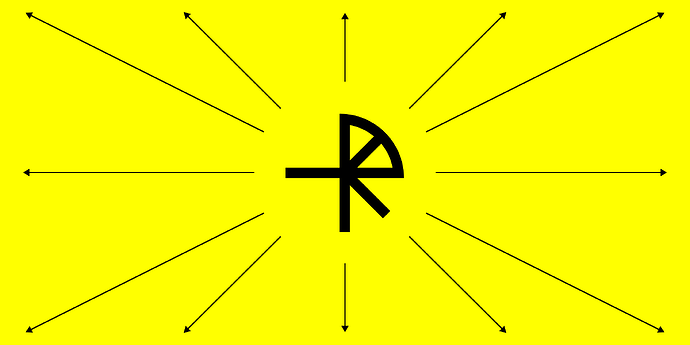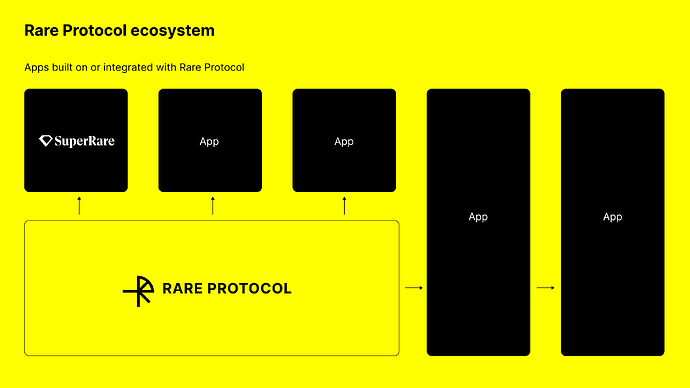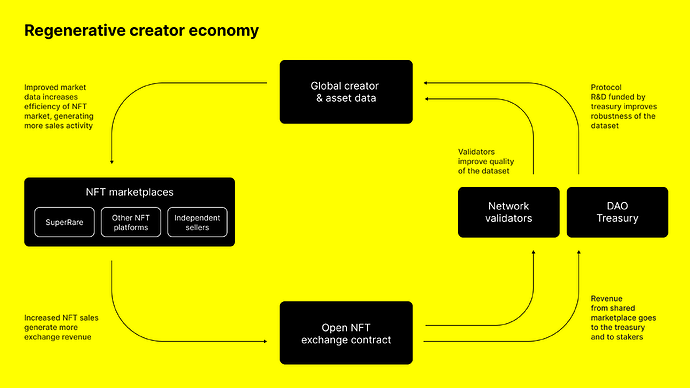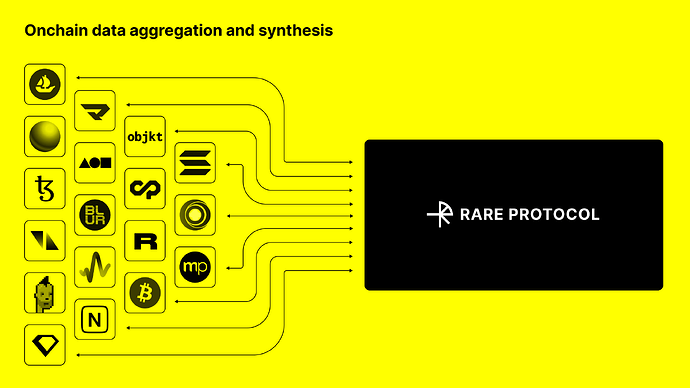Evolving from a single marketplace to a decentralized protocol for NFT discovery and authentication
Author: SuperRare Labs
Summary
We propose a change in the DAO’s priorities and structure that allows us to make a much bigger impact on the NFT sector through the introduction of Rare Protocol, in addition to continued stewardship of the SuperRare marketplace. By focusing on the problem of fragmented data in the web3 creator economy, we can radically improve cross-platform discovery and authentication, unlocking the true potential of this ecosystem.
Introduction
The web3 creator economy has exploded from a small, experimental niche, into a vibrant ecosystem of creators releasing work across countless different platforms, smart contracts and blockchains. But we lack a comprehensive registry that ties all this activity back to each creator–a canonical source of truth that provides data, insights, and asset verification, and invites further exploration into the cryptoart rabbit hole.
This data fragmentation hampers discoverability and makes authentication and curation reliant on centralized third parties. In order for the nascent web3 creator economy to scale to its full potential as a $100B+ market, we, as a community, need an autonomous decentralized registry of web3 creators, collectors, assets, and historical provenance.
We propose orienting the DAO’s long term priorities around addressing these data problems head on. In order to do this, we propose repositioning the DAO and the governance token around Rare Protocol, empowering the Foundation to take on more responsibility, and electing a new council to lead the community on this journey.
With this expanded scope, stewardship of the SuperRare platform will still remain under the RareDAO umbrella, while positioning ourselves to have a much bigger impact at an ecosystem level.
RareDAO: origins, experiments and evolution
SuperRare launched in early 2018 with the mission to revolutionize the economics of human creativity. We saw web3 as an opportunity for an entirely new kind of online creator economy to form. A better internet for digital creators. One that enabled them to earn money directly, rather than posting without compensation to advertising-driven, value-extracting web2 creator platforms such as Instagram and YouTube.
Specifically, we believed this would be unlocked by the then-recent advent of rare digital art – digital media made provably-scarce and collectible by tokenizing it on the blockchain – as pioneered by early projects like Rare Pepe, Cryptopunks and DADA.art. The initial focus of SuperRare was on enabling creators to mint and sell rare digital art as NFTs through a user-friendly interface – an important problem to solve, as there were almost no creator tools or marketplaces at the time.
Following early success and community growth, we took a huge leap toward becoming a community-run project. RareDAO was created in 2021, along with its governance token, RARE. 150M RARE were airdropped to early users of the platform, and 400M tokens were placed in the shared community treasury, committing the project to a path of progressive decentralization.
We did not choose this path because it would be easy. The decision was driven by our firm belief in one of the core tenets of blockchain: that the users of a network should be the owners of the network.
Since then, $27M has been earned by the RareDAO treasury; 568 core community members have voted on governance initiatives; we collectively tested an early method of decentralized discovery and authentication via Spaces; and we launched both testnet and mainnet-beta versions of curation staking – a novel way to promote discovery by bringing reputation onchain.
We are incredibly proud of this progress, and think it’s a good time to ask the community to join us in taking a fresh look at the NFT landscape, its biggest challenges, and how we might address these challenges together, in order to most effectively achieve our mission.
The web3 creator economy is fragmented
Since the DAO’s inception, the NFT landscape has changed dramatically. We’ve seen the launch of countless new NFT minting platforms and marketplaces. We’ve been through a massive NFT bull market cycle, during which billions more people learned about NFTs and cryptoart. And we’ve seen substantial traction with NFTs on blockchains beyond Ethereum – from EVM-based Layer-2s such as Optimism, to non-EVM chains such as Bitcoin and Tezos.
This cambrian explosion of tools and infrastructure has been a great thing for the industry, arming creators with a wide array of options. However, it has also left us with a highly fragmented ecosystem that is difficult to navigate.
For example, when a creator releases NFTs on OpenSea, SuperRare, and Art Blocks using three different Ethereum wallets, how does one know for sure that all of these NFTs are authentically created by the same person? And what might we ascertain about the reputation or other qualitative aspects of the creator, without relying on a centralized verification service like the “blue checkmark” on X or Opensea? This problem is further complicated with the inclusion of other chains popular for NFTs, such as Bitcoin, Tezos, and Polygon.
Creating a scalable, decentralized discovery & authentication layer for web3
We believe Rare Protocol can serve as an open public good – a living record that makes the web3 creator space 100x more accessible and understandable to both consumers and developers.
With this dataset, one can ask:
- What is Osinachi’s total artwork supply across all platforms and blockchains?
- Show me the set of artists in the MoMa digital photographer list
- What collectors and curators have provided attestations for this artist?
- Which creators have the most community support and connections?
- Is this NFT by a RareDAO verified artist?
- Is this artist in the RareDAO top 100 list?
This data can enrich the experience of apps across the web3 ecosystem, enabling developers to build marketplaces, social apps, AI-based art advisors, and much more.
To ensure data availability and increase trust in the dataset, it’s crucial that the protocol generating this data be decentralized and transparently governed by the community. This means it should be deployed on an L1 or L2 blockchain, and be under the purview of an active, well-organized DAO rather than a centralized operator.
One hurdle in designing an effective, crowdsourced registry is incentivizing independent actors to validate the data and keep it up to date. While we should evaluate several potential incentive models, we believe that curation staking is a compelling candidate. Early usage shows strong signs of network formation and qualitative curation signals, with participants being incentivized with marketplace rewards. Future work can iterate and improve on the staking protocol, pioneering open source data proofing and social validation.
Another challenge in public goods development is funding research and development. In this aspect, we believe we are extremely well positioned. The Bazaar NFT exchange contract is already an open, shared marketplace with revenue flowing to the DAO treasury and to stakers, who, as mentioned above, can be seen as validators in the network.
This sets up the project for sustainability and growth, creating a regenerative creator economy shared by all DAO members.
A bold, new vision for RareDAO
The opportunity at hand is a massive one: together, by establishing an open, decentralized discovery and authenticity system, we can, for the first time in history, make the internet truly work for creators. Thus, the vision for RareDAO is much bigger than a single platform.
We envision an open content-discovery system which does not exploit user data to feed a faceless algorithm, but instead uses the network effects afforded by large social graphs to amplify the role of real humans in curating the content they consume and create. This starts with cryptoart, but can be applied across any content medium. We see a much wider opportunity which addresses broad societal issues that are emerging as the cost of content creation continues to decrease and the systems we use to make sense in the world are fraying at the edges. At the end of it all, we believe Rare Protocol could serve as a new curation & discovery layer for the entire internet.
All new protocols and networks suffer from the cold start problem, however in this case we do not. SuperRare and RareDAO are in the perfect position to help bootstrap this system. We are an engaged community of some of the world’s best artists, collectors, and curators. By leveraging Rare Protocol, the SuperRare platform will demonstrate the power of the underlying protocol, and continue to grow and evolve as a project guided and supported by the DAO.
Proposal for next steps
This is a significant undertaking, but the journey of a thousand miles begins with a single step (or in this case, three). In close partnership with the DAO Council and RareDAO Foundation, we have identified three initial areas of focus to facilitate this structural shift.
- Unifying the smart contracts and DAO under the Rare Protocol brand.
- Carrying out RareDAO’s first council election.
- Formalizing the role of the RareDAO Foundation in progressive decentralization by setting a clear annual budget.
Each recommendation is discussed below. Based on initial discussion around this Request for Comment, we will introduce each recommendation as its own proposal at the beginning of December for more specific feedback and voting.
Branding
At present, the branding around the DAO is very SuperRare dependent. This presents some advantages by allowing the DAO to benefit from SuperRare’s name recognition and prestige. But it also limits the scope of the DAO to a particular mental model which revolves around the SuperRare marketplace. In order for the DAO to carve out its own place in the world, we believe that it and all of its properties should be consolidated under the Rare Protocol brand, which we’ve been piloting since the introduction of curation staking earlier this year.
If the proposal that follows this RFC passes, any mentions of the “SuperRare DAO” in official documentation would be changed to “RareDAO” (in alignment with the existing name for the RareDAO Foundation), and any references to the “SuperRare Network” would be changed to “Rare Protocol”. In addition, the forum would be migrated to forum.rare.xyz, and the name and branding of the token on centralized exchanges would be updated to “Rare Protocol”, (keeping the ticker, “RARE”, the same), and other venues such as the DAO’s snapshot space, would receive similar updates.
The SuperRare brand will continue to live under the umbrella of RareDAO, similar to how Louis Vuitton lives under the umbrella of LVMH. SuperRare is built on top of Rare Protocol, and will maintain its own brand identity.
We believe that this will bring much needed clarity around the fact that the DAO’s ambitions extend far beyond SuperRare and increase our ability to drive adoption of the open data protocol, while still staying true to our roots and honoring the continued connection between the SuperRare marketplace and the underlying protocol.
Electing a new council
When the DAO was initially formed two years ago, a council of 7 respected community members was appointed to steward the treasury, control access to protocol upgrades, and oversee the process of progressive decentralization. Since then, the council has established robust bylaws for the council and foundation, established working groups to facilitate operations and community grants, and overseen protocol development from the cultivation of curation staking through a handful of smaller protocol upgrades. Going forward, we believe that a strong council remains critical to the cultivation of wisdom and sound strategy within the DAO and will play a foundational role as we continue to evolve.
With the conclusion of the initial two year term upon us, it is time to elect a new cohort. We have already identified a nomination and election process based on that of ENS, which we believe will suit our needs well. Some details are still being finalized, and we plan to release an outline of the detailed process in conjunction with the SIP that comes out of this RFC. In addition to instituting a new election process, we propose two changes to the council’s current structure:
- Term length: We believe that the term length should be shortened from two years down to one. This will allow more people to be involved and increase accountability while giving each member enough time to adjust to their position and create change.
- Compensation: We believe that council members should be compensated for their time and dedication. The existing council has generously served on an entirely volunteer basis for over two years, attending monthly meetings, contributing to the SIP process, and hopping on countless sidebar and one-on-one calls. We will put forth a proposal with three options, one with no compensation, one with lower compensation, and one with higher compensation, and let the community choose the amount they feel is fair by voting on Snapshot. More specifics about these amounts and an outline of council responsibilities will follow in the subsequent proposal.
Establishing a budget for the RareDAO Foundation
In addition to forming the council at the DAO’s inception, the RareDAO Foundation was created to serve as a legal entity for the DAO, ensuring regulatory compliance and liability protection for token holders and DAO contributors alike. As we have developed processes which gradually offload responsibility from SuperRare Labs onto the Council and DAO contributors, the importance of the Foundation’s role as a vehicle for progressive decentralization has increased.
As such, we propose that an annual budget be established for the Foundation, which will give its Director and the DAO Council more autonomy to perform work independent of SuperRare Labs. A primary initial focus will be identifying work currently being performed within SRL that primarily concerns DAO Operations and transferring it to the foundation, making the areas of responsibility for each entity clearer, and opening the door for further decentralization. In addition, this will create more transparency around existing overhead such as corporate costs and legal fees.
The Foundation Director’s recommendation for the first annual budget, which will be accompanied by a 6-month transparency report, is as follows:
| Category | Amount* |
|---|---|
| Corporate Expenses (Director, Annual Fees, Supervisor) | $50,000 |
| Employees & Contractors (DAO Ops & Protocol Development) | $150,000 |
| Employees & Contractors (Marketing & Community Management) | $150,000 |
| OpEx & Service Providers (Gsuite, Slack, Hats Protocol) | $50,000 |
| Total | $400,000 |
* Final amount/denomination TBD based on community input
A call to adventure
The NFT ecosystem is fragmented. As a community, we have a massive opportunity to make it vastly more valuable and accessible, by developing scalable and credibly neutral systems for discovery, provenance, and exploration. This won’t be easy, but it’s possible with the right focus, funding, and hustle.
Most importantly, we can’t do it alone. A healthy DAO is critical to our success, and if we succeed, Rare Protocol can become a valuable layer of connective tissue tying all NFT creator platforms and marketplaces together. To help make that happen, please let us know what you think about this vision, and provide feedback on the next steps that we’ve outlined. Please comment on this post with your honest opinions, and join the upcoming X spaces and town halls, and make your voice heard.
In addition to frequent product updates in our Discord and weekly community conversations on X, here is an outline of what’s coming next as we work towards proposing and implementing (if approved) the action items outlined above:
Nov 22: Community Townhall and Q&A #1 ![]()
Nov 29: Community Townhall and Q&A #2 ![]()
Dec 1: Initial proposals posted to the forum ![]()
Dec 6: Community Townhall and Q&A #3 ![]()
Dec 13: Feedback incorporated as amendments to the original proposals ![]()
Dec 15: Proposal voting begins on Snapshot ![]()
Dec 22: Proposal voting concludes
Week of Jan 1: Proposal implementation begins, council election details announced




